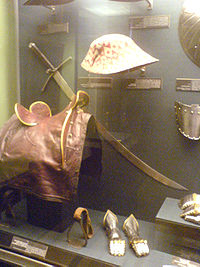Big knife
| Big knife | |
|---|---|

|
|
| Information | |
| Weapon type: | Knife, saber |
| Use: | Civil and military weapon |
| Creation time: | approx. 16th century |
| Working time: | 16th century - approx. 17th century |
| Region of origin / author: |
Holy Roman Empire of the German Nation |
| Distribution: | Holy Roman Empire of the German Nation |
| Overall length: | about 107 cm |
| Blade length: | approx. 81 cm |
| Blade thickness: | approx. 5 mm |
| Weight: | about 1.8 kg |
| Handle: | Wood, metal, bone |
| Particularities: | In terms of appearance, it could be classified under the sword or saber category. But it belongs to the knives |
| Lists on the subject | |
The large knife was an often used European bladed weapon around 1500 . This bladed weapon was considered a knife and saber and not a sword . Depending on the version, it could be used with one or two hands.
nature
The blade was forged from carbon steel and ground extremely sharp and single-edged. In contrast to the long knife with a straight course and uniform cross-section, the large knife was saber-like and had a widening just before the point. Nevertheless, both terms are often used synonymously. On the quillons there was a shell-shaped attachment, the so-called nail.
origin
The saber-like blade shape of this weapon was inspired by the Eastern European sabers, especially the Turkish weapons. In the Kunsthistorisches Museum in Vienna a few pieces of well-preserved are kept.
Web links
- Illustration and description (English)
literature
- John Clements: Medieval Swordsmanship: Illustrated Methods and Techniques . Paladin Press, 1998. ISBN 1581600046